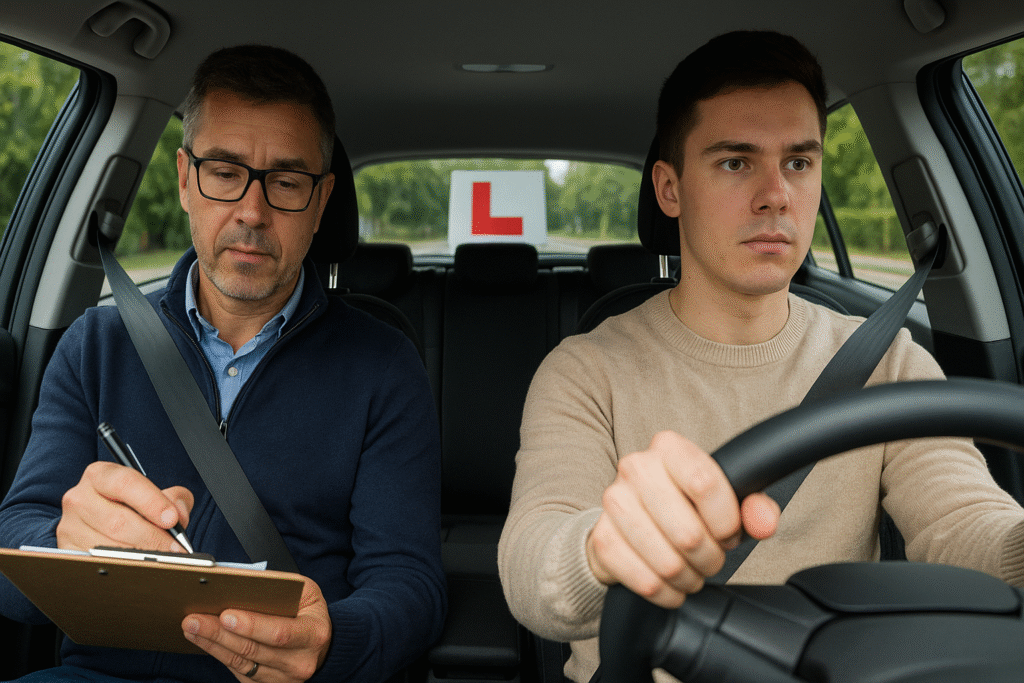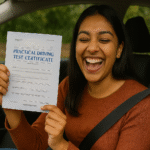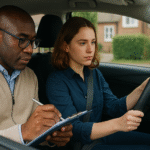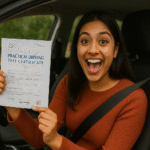Comparing the Challenges: Is the Practical Driving Test Harder than the Theory Test?
When learning to drive, one of the essential milestones to achieve is passing both the theory and practical driving tests. You might find yourself asking, “Is the practical driving test harder than the theory test?” This question is common among new drivers, and understanding the differences between the two can help you better prepare for the challenges ahead.
Theory tests are primarily knowledge-based, focusing on your understanding of road signs, rules, and safety regulations. In contrast, practical tests evaluate your ability to operate a vehicle competently and safely in various driving conditions. Let’s explore the challenges of each test in more detail.
Understanding the Theory Test
The theory driving test involves multiple-choice questions and hazard perception segments. The questions cover topics such as:
- Traffic signs
- Rules of the road
- Road safety
- Driving procedures
To pass, candidates usually need to score a minimum of 43 out of 50 in the multiple-choice section and a set score in the hazard perception part. While many candidates find the theory test easier due to its focus on knowledge, it can still pose challenges:
- **Memorization:** Many facts and rules must be remembered, which can be overwhelming for some.
- **Visual recognition skills:** The hazard perception test requires you to quickly identify potential hazards, which can be tricky without real-time experience.
Challenges of the Practical Test
On the other hand, the practical driving test is hands-on and involves demonstrating your driving skills on the road. You’ll need to perform various maneuvers, including:
- Parallel parking
- Three-point turns
- Lane changes
- Adapting to road conditions
Unlike the theory test, the practical test is more subjective, meaning it can be seen as more challenging for several reasons:
- **Real-world pressure:** Being in a live traffic environment can heighten stress levels.
- **Application of knowledge:** You must apply your theoretical understanding practically, which may be difficult for those who are inexperienced.
Comparative Analysis of Difficulty
While one person may find the theory test more challenging, another might struggle with the practical test. This variability often depends on individual strengths and weaknesses. Here is a comparison breakdown:
| Aspect | Theory Test | Practical Test |
|---|---|---|
| Format | Multiple-choice and hazard perception | Hands-on driving with a certified examiner |
| Knowledge Required | Rules, signs, and regulations | Hands-on skills, judgment, and application of theory |
| Type of Risk | Low-risk (no physical activity) | Higher risk due to driving in real traffic |
| Nervousness Level | Generally lower | Potentially higher due to performance pressure |
Ultimately, whether the practical driving test is harder than the theory test comes down to personal experience and comfort levels. Some may excel in knowledge retention, making the theory test feel easier, while others may have better driving instincts, feeling more capable in practical settings.
Tips for Success in Both Tests
To successfully navigate both tests, consider the following preparation strategies:
- **Study Regularly:** Consistent review of the material for the theory test can boost retention of road rules and signs.
- **Practice Driving:** Gaining experience behind the wheel will improve confidence for the practical test.
- **Take Mock Tests:** Online theory test simulators can help reinforce knowledge and reduce anxiety.
- **Stay Calm:** Focus on relaxation techniques to help manage stress on test day.
The challenge of driving tests can vary significantly based on individual strengths. Whether you find the theory or practical test more difficult, preparing thoroughly for both is only going to benefit you as a future driver. Remember, practice is key to excelling in both areas and becoming a safe, confident driver.
Strategies for Success: Tips to Pass Your Practical Driving Test
Passing your practical driving test is an essential step toward gaining your driver’s license. While many people find the theory test challenging, the practical driving test can feel even more daunting. Having the right strategies in place can make all the difference in ensuring your success. Here are some effective tips to help you pass your practical driving test with flying colors.
Practice Regularly
One of the most critical factors in passing your practical driving test is consistent practice. The more time you spend behind the wheel, the more comfortable you will become with the controls and road situations. Aim to schedule regular practice sessions that focus on various driving skills.
- Steering control: Work on your ability to steer smoothly and accurately.
- Parking maneuvers: Spend extra time practicing parallel parking, parking on a slope, and backing into spaces.
- Traffic situations: Drive in different areas to encounter a variety of road types, including busy streets and rural roads.
Take Lessons with a Qualified Instructor
Consider investing in lessons with a qualified driving instructor. They can provide you with invaluable tips tailored to your local test requirements. A professional instructor will also help you identify areas that need improvement, providing structured feedback to help you grow as a driver.
Familiarize Yourself with the Test Route
Knowing the practical driving test route in advance can give you a significant advantage. Most driving examiners follow specific routes during the test. Familiarize yourself with the roads and potential hazards in that area. Drive with a friend or family member who can help you navigate these routes and point out any tricky sections.
Know Your Vehicle
Being comfortable with your vehicle is essential for a successful test. Make sure you understand how to operate essential functions, such as:
- Headlights and wipers
- Indicators and hazard lights
- Clutch, brakes, and accelerator (for manual vehicles)
- Adjustment of mirrors and seats
Before the test, spend time getting familiar with your car’s features. This knowledge will build your confidence and help you feel more in control.
Stay Calm and Focused
Feeling nervous before your driving test is entirely normal. Here are some strategies to help you stay calm:
- Practice relaxation techniques: Before your test, take deep breaths and visualize a successful drive.
- Arrive early: Give yourself plenty of time to get to the test center without rushing.
- Stay positive: Remind yourself of your practice and preparation. Confidence is key!
Understand the Test Criteria
Familiarize yourself with how the practical driving test is scored. Knowing what the examiner is looking for can help you focus your efforts where they matter most. The key categories include:
| Criteria | Points deducted for faults |
|---|---|
| Control of the vehicle | Minor: 1-3; Major: 4+ |
| Observation and awareness | Minor: 1-3; Major: 4+ |
| Manoeuvring | Minor: 1-3; Major: 4+ |
| Speed and road positioning | Minor: 1-3; Major: 4+ |
Review these criteria and focus your practice on eliminating potential faults that could lead to point deductions.
Ask for Feedback After Your Practice Sessions
After each practice session, take time to review with your instructor or the person accompanying you. Discuss what went well and what can be improved. Constructive feedback is instrumental in identifying persistent issues that might need extra attention before the big day.
Stay Engaged with Your Learning Process
Keep an open mind and remain engaged as you learn to drive. Stay curious, ask questions, and seek advice from experienced drivers. The more you engage in your learning process, the better equipped you will be to tackle the challenges that may arise during your driving test.
By focusing on these strategies, you will significantly increase your chances of passing your practical driving test and becoming a confident, skilled driver. Remember, preparation is key, and with commitment and practice, you can achieve success!
Understanding the Theory Test: Key Concepts and Topics You Must Know
When it comes to preparing for your driving test, understanding the theory test is vital. This part of the exam evaluates your knowledge of road rules, safety measures, and essential driving principles. Knowing what to expect can help you approach it with confidence. Let’s explore the key concepts and topics you must grasp to succeed in the theory test.
Road Signs
Identifying road signs is crucial for safe driving. You will encounter various types of signs during the test, and they can be grouped into categories:
- Warning Signs: Indicate potential hazards, such as sharp turns or animal crossings.
- Regulatory Signs: Provide instructions that you must follow, like speed limits and no parking zones.
- Informative Signs: Offer helpful information about road conditions, distances, and directions.
Traffic Laws and Regulations
Understanding traffic laws is key to passing the theory test. You’ll need to know the rules regarding:
- Speed limits: Different limits apply in residential areas, highways, and construction zones.
- Right of way: Who has priority in various driving situations, including intersections and roundabouts.
- Alcohol limits: Know your limits and the legal consequences of driving under the influence.
Vehicle Control and Safety
Another essential area covers vehicle control and safety measures. This section emphasizes:
- Importance of seat belts: The role of restraints in protecting both the driver and passengers.
- Stopping distances: How to calculate the distance needed to safely stop at various speeds.
- Adjusting mirrors and seats: Proper positioning for maximum visibility and comfort.
Hazard Perception
Hazard perception is a unique component of the theory test, where you must identify potential dangers on the road. You will be presented with clips of everyday driving scenarios and asked to pinpoint hazards as they appear. Key strategies include:
- Anticipating actions: Look for signs of other drivers’ intentions, like turn signals.
- Identifying risks: Keep an eye out for pedestrians, cyclists, or changing road conditions.
- Reacting promptly: Knowing when to slow down or change lanes can prevent accidents.
Road Safety and Emergency Procedures
Understanding road safety is fundamental. Here are important topics in this category:
- How to deal with emergencies: What steps to take if you encounter an accident scene.
- Breakdown procedures: Knowing how to safely stop and signal for assistance.
- Emergency vehicles: Understanding the protocol when an emergency vehicle approaches.
Understanding Different Vehicle Types
Knowledge of various vehicle types is also important. Different vehicles behave differently on the road, so you must grasp the following:
- Differences between motorcycles, cars, and trucks: Understand their dimensions and how they affect traffic.
- Driving alongside large vehicles: Recognize blind spots and how to navigate around them safely.
Environmental Awareness
Awareness of environmental impacts is increasingly becoming a focus in driving theory tests. Topics in this area include:
- Eco-friendly driving: Tips on reducing fuel consumption and minimizing emissions.
- Understanding road conditions: How weather impacts driving and what precautions to take.
| Topic | Key Points |
|---|---|
| Road Signs | Warning, Regulatory, Informative |
| Traffic Laws | Speed limits, Right of way, Alcohol limits |
| Vehicle Control | Seat belts, Stopping distances, Mirror adjustments |
| Hazard Perception | Anticipate actions, Identify risks, React promptly |
| Road Safety | Emergency procedures, Breakdown protocols, Emergency vehicles |
| Vehicle Awareness | Understanding different vehicles, Handling large vehicles |
| Environmental Awareness | Eco-driving, Weather impacts |
Understanding these fundamental concepts not only prepares you for the theory test but also equips you with the knowledge to become a responsible driver. Investing time in studying these components will pay off when you pass your driving theory test and take the next steps toward becoming a licensed driver.
Real-Life Experiences: Feedback from Drivers on Both Tests
When it comes to learning to drive, understanding what to expect from both the practical and theory tests can make all the difference. Many drivers have shared their experiences and insights on how these two assessments compare. From the perspectives of those who have taken both tests, distinct themes emerge that may help you in your own preparations.
First, let’s look at the feedback regarding the theory test:
- Studying Techniques: Some drivers emphasized the importance of using multiple study methods. They recommend reading the manual, taking online quizzes, and watching instructional videos to grasp the rules of the road better.
- Mock Exams: A number of drivers found practice tests invaluable. They often mentioned that taking mock exams helped them get accustomed to the format and timing of the real test.
- Nerves and Pressure: Many learners reported feeling anxious during the theory test. The stress of a ticking clock can add pressure, making focus more challenging.
Conversely, the feedback from experienced drivers about the practical driving test reveals different challenges and stresses associated with this hands-on assessment:
- Real-Life Hazards: Drivers noted that navigating actual traffic situations adds a layer of complexity not present in the theory test. Many felt that their ability to remain calm and focused in real-life conditions was crucial.
- Instructor Expectations: Test-takers often mentioned the need to perform reliably under the scrutiny of a driving examiner. The desire to impress while also driving safely can be stressful.
- Experience vs. Inexperience: Some insights point out that novice drivers may struggle more than those with some driving experience. Those familiar with driving found the practical test more straightforward than those who were taking the wheel for the first time.
Many learners expressed that preparation for both tests is essential. The combination of knowledge from the theory test and skills from the practical test is what ultimately makes a safe driver. Here’s how the two tests appear to stack up against one another based on feedback from drivers:
| Test Type | Challenges | Preparation Required | Nerves Level |
|---|---|---|---|
| Theory Test | Memorization and understanding rules | Study materials, mock tests | Moderate |
| Practical Test | Real-world driving situations | Driving practice, understanding car handling | High |
It’s also worth noting that both tests have different types of pressure. For example, while the theory test is usually timed and based on knowledge, the practical test puts your driving abilities to the test in a live environment. Drivers who have passed both often note that each test supports the other. Knowledge from the theory helps you perform better on the road, while real-life driving experiences can reinforce your theoretical understanding.
Furthermore, seasoned drivers often remind new learners to manage their expectations. Everyone learns at their own pace, and what might be a struggle for one person may come easily to another. Engaging with others, sharing experiences, and talking about what to expect can alleviate some nerves. Others suggest forming study groups where learners can discuss tricky aspects of theory or practice driving in groups for support.
Ultimately, both the practical and theory tests are integral parts of obtaining a driver’s license. While experiences differ, the underlying theme is that adequate preparation and a calm mindset can significantly improve your chances of success in either test. You may find that your confidence in one aspect can positively influence your performance in the other, making both tests equally important in your journey to becoming a skilled driver.
The Importance of Preparation: How to Balance Study for Theory and Practice for Driving
When it comes to obtaining your driver’s license, mastering both practical driving skills and theoretical knowledge is key. Many learners often wonder about the importance of preparation and how to balance studying for the theory test while also honing practical driving skills. This balance is crucial, as both components are interconnected and essential for becoming a safe driver.
Preparing effectively for the theory test involves more than just memorizing traffic signs and rules of the road. You need to understand concepts such as road safety, hazard perception, and the implications of driving under different conditions. Here are some effective strategies to help you ace the theory portion:
- Create a Study Schedule: Designate specific times each week to study different theory topics. This structured approach helps avoid cramming and ensures you cover all necessary materials.
- Use Practice Tests: Familiarize yourself with the exam format by taking practice tests. This not only builds your confidence but helps identify areas where you may need additional review.
- Utilize the Right Resources: Invest in good study materials, such as official guides or apps. These resources often provide comprehensive reviews and simulate the test environment.
- Join Study Groups: Engaging with peers can enhance your understanding. Explaining concepts to others can reinforce your knowledge.
On the other side, practical driving is where the theory comes to life. You’ll need to apply what you’ve learned in real-world scenarios. Here are some suggestions to help you prepare for this essential aspect:
- Take Professional Lessons: While practicing with friends or family can be beneficial, professional trainers can provide you with expert guidance and feedback.
- Practice Regularly: Make a habit of driving as often as possible. Consistent practice helps build muscle memory and increases your confidence behind the wheel.
- Learn in Various Conditions: Diversifying your driving experience by tackling different situations, such as night driving, highway driving, or driving in rain, prepares you for anything on the day of your test.
- Focus on Specific Skills: Identify areas where you may struggle, such as parking or parallel maneuvers, and dedicate extra practice time to these skills.
Balancing theory and practice can seem challenging. However, integrating them into your study routine can make the process smoother. When you study a new traffic rule, try to practice it during your next driving session. That connection can reinforce your learning. For instance, if you learn about right-of-way rules, practice intersections by consciously applying that knowledge while driving.
Moreover, keeping a driving journal can be an effective strategy. You can document lessons learned during practice drives, including what you did well or what needs improvement. Reflecting on these experiences will enhance both your skills and theoretical understanding.
Time Management Techniques
Another essential aspect of balancing your study for theory and practice is effective time management. Here are some techniques you can use to make the most of your preparation time:
- Set Specific Goals: Define clear objectives for each study session. Instead of just saying you’ll study, specify that you’ll learn about signaling or work on parallel parking.
- Prioritize Tasks: Identify what needs more attention. If you’re confident in your theory knowledge but struggle with driving skills, focus on the practical side for a while.
- Break It Down: Split your study sessions into manageable chunks. For example, study for 25 minutes and take a 5-minute break. This method can enhance retention.
Your success in passing both the theory and practical driving tests hinges significantly on your level of preparation. Striking a well-balanced approach ensures you are not just test-ready but also equipped to handle real-life driving situations safely. Remember, the goal is not just to pass a test but to become a competent and responsible driver.
Effective preparation for both the theory and practical driving components requires a strategic approach. By prioritizing your time, utilizing the right study resources, and integrating your learning experiences, you will build a solid foundation for your driving career. Whether you prefer studying in groups or learning independently, find a method that suits your style and stick with it. Your dedication will undoubtedly pay off when you confidently hit the road.
Key Takeaway:
When considering whether the practical driving test is harder than the theory test, it’s important to factor in various elements that make each unique experience. The challenges you encounter in the practical exam often involve real-time decision-making and physical handling of a vehicle, while the theory test primarily focuses on your understanding of road signs, rules, and regulations. For many, the practical test may feel more intimidating due to the hands-on nature and the pressure of performing in front of an examiner. However, this intensity can also nurture valuable driving skills that are essential for road safety.
To succeed in your practical driving test, it’s essential to adopt effective strategies. These include practicing regularly with a licensed instructor, understanding the test route, and simulating test conditions. Engaging in mock tests can also boost your confidence and highlight any areas needing improvement. Moreover, real-life experiences shared by past drivers can provide insights into the common pitfalls and unexpected challenges that arise during these tests, helping you better prepare.
On the other hand, mastering the theory test requires a solid grasp of fundamental concepts. Key topics often include road signs, traffic rules, and hazard perception. It’s beneficial to utilize various study resources, such as official driving handbooks and online quizzes, to reinforce your knowledge and familiarize yourself with the test format.
Preparation plays a crucial role in balancing your study for the theory test and practice for the driving test. Developing a schedule that allows for dedicated time to study the theory while also getting behind the wheel will enhance your overall readiness.
While both the practical driving test and the theory test present their own sets of challenges, many aspiring drivers find the practical test to be the more formidable of the two. Balancing preparation for both is key to achieving success on your path to becoming a competent and safe driver.
Conclusion
Choosing between the practical driving test and the theory test when considering which is harder can be challenging. Each presents unique hurdles that require distinct preparation strategies. While the theory test assesses your understanding of rules, car handling, and safety, the practical driving test evaluates your actual driving skills in real-world scenarios. Many learners find that the pressure of performing while being observed makes the practical test feel more daunting.
Preparing for the practical test involves regular practice behind the wheel, including mastering road maneuvers and developing an intuitive understanding of traffic situations. To increase your chances of success, consider enrolling in professional driving lessons and practicing with an experienced driver who can provide constructive feedback. On the other hand, the theory test relies on memorization and comprehension of key concepts like road signs and driving laws. Utilizing study guides and taking practice tests can greatly enhance your chances of passing this first step.
Feedback from those who’ve undertaken both tests often reveals that personal experiences vary widely. Some report that practical tests were nerve-wracking but manageable with adequate hands-on practice, while others found the theory test overwhelming due to its breadth of content. Balancing your study efforts between both tests is crucial. Recognizing the demands of each can help you set a study schedule that allows for comprehensive preparation.
Ultimately, whether one test is harder than the other often depends on your personal strengths and weaknesses. By understanding both tests thoroughly and employing effective study and practice strategies, you can boost your confidence and improve your chances of success. Mastering both components is essential for becoming a safe, responsible driver.






Leave a Reply